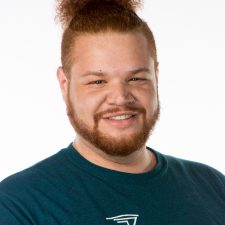Sound is all around us, but what exactly is it? Simply, sound is just vibrations in the air. There are so many fun activities you can try to experiment with sound, so we are here to show you just a few of them. Go ahead, grab you materials and follow along with us below.
Materials to Collect
- Rubber bands
- Cups
- Water
- Wineglass or other thin-walled glass (with adult supervision!)
Try it!
Rubber Bands:
- Stretch a rubber band around a cup, making sure the band stretches across the opening of the cup.
- Pluck the rubber band – can you see it moving back and forth?
- Try a different size cup – does the noise sound the same?
Wine Glass:
- Pour some water into a wineglass – ask an adult for help with this activity!
- With one hand holding the bottom of the wineglass steady on the table, or an adult helping to hold the glass steady, dip a finger from the other hand into the water, and then run your fingertip in a circle around the top of the glass – do you hear anything?
- Try changing the amount of water in the glass and see what happens!
What is the Science?
All sound is made by some material moving back and forth very quickly, or vibrating! When a material vibrates, it makes the air around it vibrate, and eventually those vibrations reach our ears where tiny parts inside our ears vibrate as well. Those vibrations send a signal to our brain that tells it we are hearing a sound. Different materials like the glass or the rubber band vibrate differently, which produce different sounds. The water in the wineglass vibrates just like the air molecules do, but we can actually see these vibrations happening as well as hear them!
When we change the size of the cup that the rubber band is stretched around, the rubber band may get tighter or looser. When it is tighter, it can only move a short distance back and forth, which makes a higher pitched sound. But when the rubber band is looser, it can move a much greater distance back and forth, which makes a much lower pitched sound. The same thing happens with our vocal cords when we talk or sing! When we sing a high note, our vocal cords are stretched longer and tighter, but when we sing a lower note, our vocal cords are more relaxed and shorter. You can check it out in this video by the Royal Institution where they asked an opera singer to sing while they used a tiny camera device called an endoscope to look at her vocal cords (fair warning: the inside of a throat is very slimy and weird-looking!)) You can also click here for a video diagram of the muscles and bones and their movement when we talk and sing.
Ask Your Young Scientists
- What happens if you use a tall cup or a short cup? How tight is the rubber band stretched? How does that affect the sound?
- What happens if you touch the rubber band after you pluck it? What happens to the sound?
- What happens to the sound the glass makes when we put more water into the glass? What happens if there is less water?
More to Explore
Science at Play Pitch Cups: Learn how to change the pitch of a sound by using different amounts of water
Science at Play Sound Toys: Try making two different noise makers at home
Science Sunday Halloween Sounds: Discover ways to make some spooky Halloween movie sound effects!
SciShow Kids What Is Sound?: Learn more about sound and how we hear it.
This content was made possible in part by the Institute of Museum and Library Services.
Share your experiments with us by tagging us with #ScienceAtPlay and #CTScienceCenter, we would love to see what you find!

Jessie Scott is a STEM Educator who enjoys encouraging students’ enthusiasm for science. She teaches classes to students visiting the Science Center and brings STEM lessons to schools across Connecticut. Jessie completed her Master of Science degree in Microbiology at Dartmouth College and worked as a science educator at the Montshire Museum of Science before coming to the Connecticut Science Center. Her scientific interests are: biology – how living things have adapted different strategies to survive in their environments, insects, and plants. In her free time, Jessie likes to go rock climbing, hiking, and skiing.

Justin Riley is the Teen Programs Coordinator and STEM Educator at the Connecticut Science Center, where he works closely with high school students giving them access to STEM and leadership programming. Justin graduated from the University of Hartford with his Bachelors in Electrical Engineering Technology and a Masters degree in Counselor Education and Student Development. Justin has worked several years with a wide range of students from pre-k to college. His love of engineering and mentoring led him to the Connecticut Science Center where he gets to use his many talents to work and connect with the students in the Greater Hartford area. When he is not helping to run the teen program, he spends his time traveling and spending close time with family and friends.



